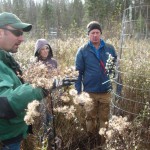
Scott Kuiti (L) of Lake Superior Steelhead Association shows off the cages used to protect conifer plantings along the Knife River in a project funded by the Outdoor Heritage Fund
What would happen if we had all the money we needed for clean lakes, clean rivers, and vital habitat? In Minnesota, that’s not just wishful thinking, it’s a real strategic goal. The Clean Water, Land and Legacy Amendment just finished its fifth year of funding conservation work across the state, and the results are tangible…including the results on a landmark North Shore river.
The Legacy Amendment created an additional three-eighths of one percent sales tax, generating around $350 million per year. These extra funds are divided up into three equal buckets: the Clean Water Fund, the Outdoor Heritage Fund, and a third bucket of parks and cultural funds. Legacy funding and the extra sales tax are scheduled to expire in 2034.
Here on the North Shore of Lake Superior, the Knife River is a great place to see these tangible results. The Knife is one of the larger streams on the North Shore, is home to many engaged citizens, and has habitat for game fish and other aquatic creatures. It’s now a showcase of the great work these Legacy funds can accomplish. All told, nearly three million dollars of Legacy funds have been invested in the Knife River watershed.
The Clean Water Fund (the first of the three buckets) supported an innovative landowner outreach project that helped private landowners along the Knife River improve their riverbank properties through tree planting and rain gardens. A large grant from the Clean Water Fund covered most of the cost of restoring two clay banks that were eroding badly into the Knife. Even though Clean Water Funds are only available to government bodies, these projects had real impact for the river and the watershed community.
The Outdoor Heritage Fund (the second of those three buckets) has proven to be highly useful on the Knife River, for both government agencies and community organizations. With the guidance of the Lessard-Sams Outdoor Heritage Council, at least six stretches of the river are now protected with a conservation easement and open to anglers to come fish for trout. MEP member group Minnesota Land Trust has protected almost 200 acres of shoreline forest for water quality and for future generations. The Lake Superior Steelhead Association, a group of Duluth-area volunteers, is now a major player in riparian habitat restoration on the Knife.
Thanks to these projects, the water in the Knife River is getting cleaner. Turbidity has dropped and conifer trees are returning to the river banks. Landowners are fired up and working with agencies to get more projects going.
Given all this success on the Knife River, it’s no wonder that watershed residents are planning to attend the Fifth Anniversary Celebration and Forum, on Thursday, January 15, in Brooklyn Park, outside Minneapolis. The Forum will include panel discussions by legislators, conservation leaders and others on the status of projects and programs made possible as the result of Minnesota’s Clean Water, Land and Legacy Amendment. All are invited. Join the good people of the Knife River in acknowledging the work of the Legacy funds.